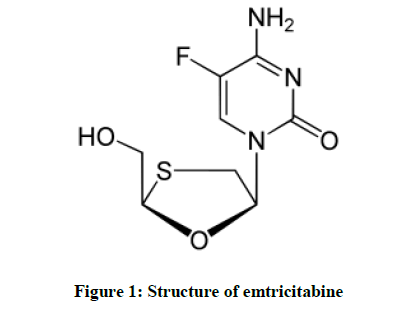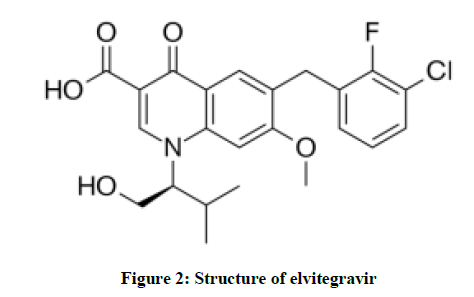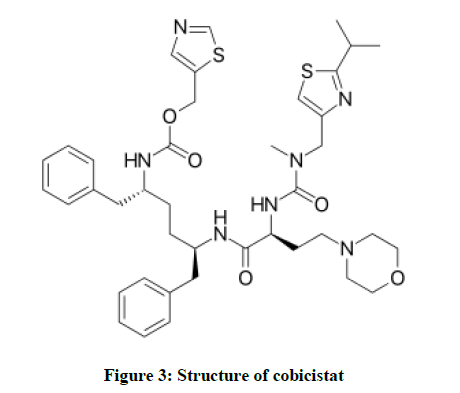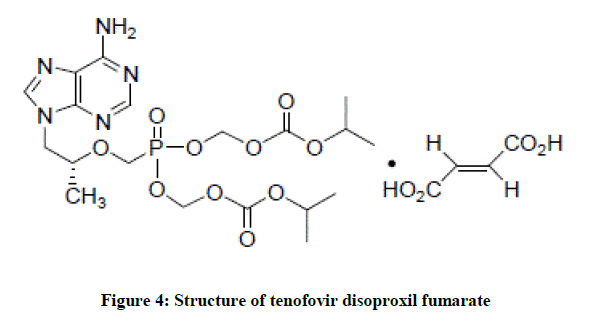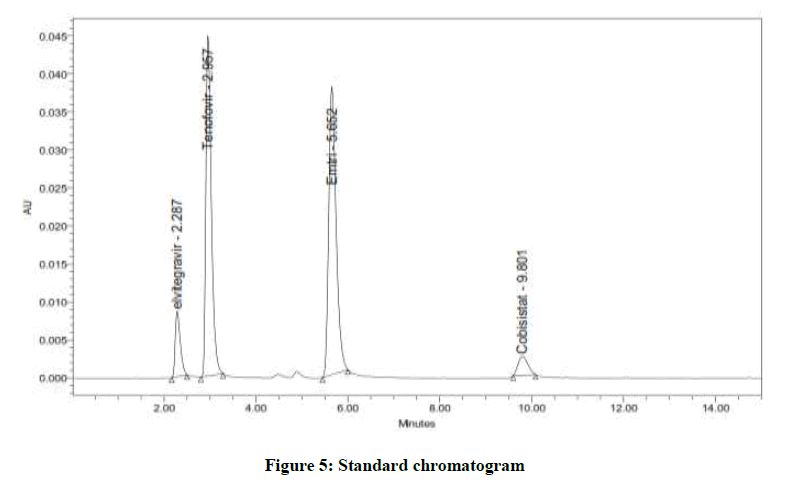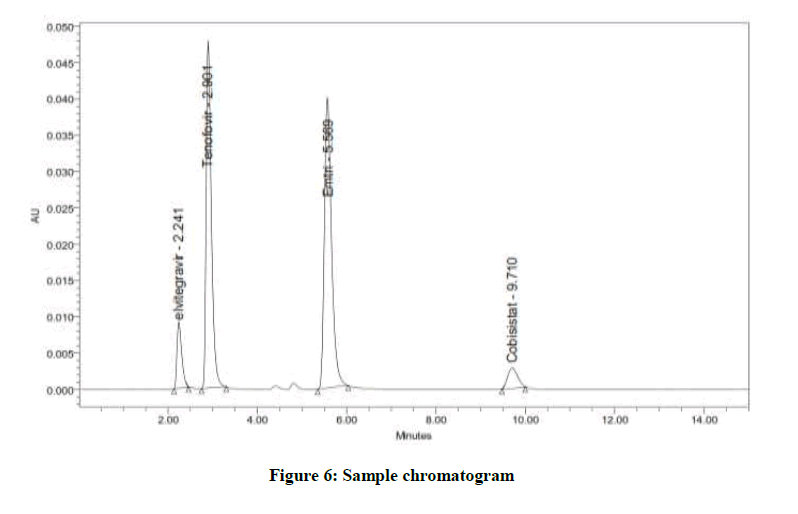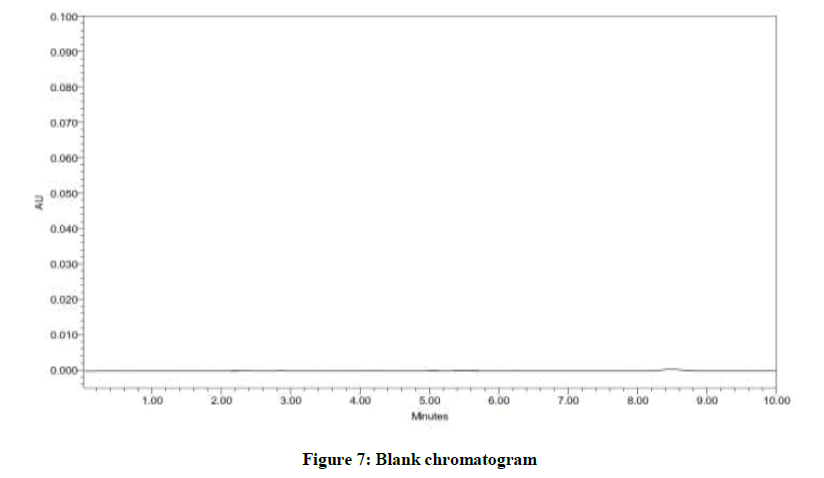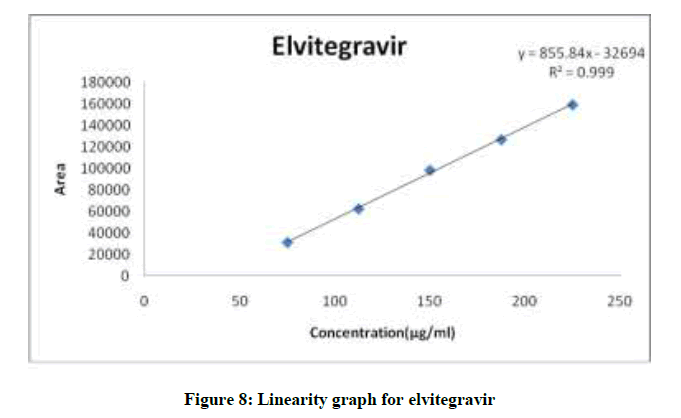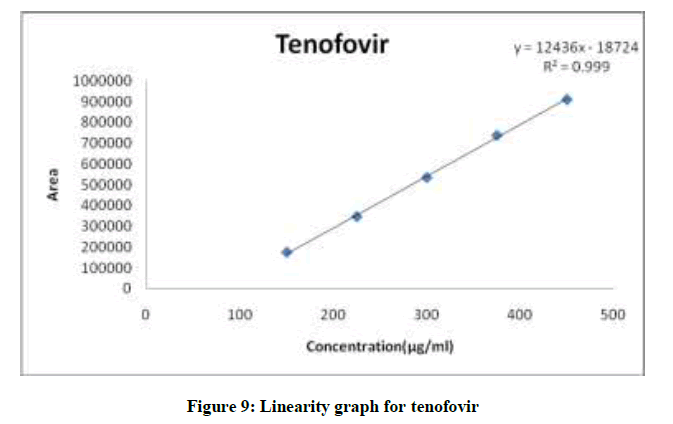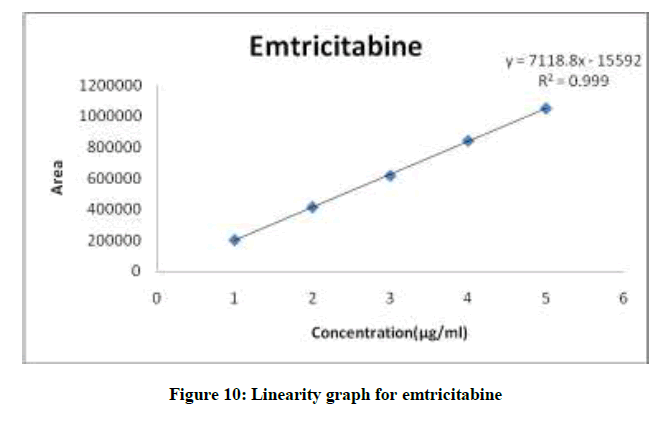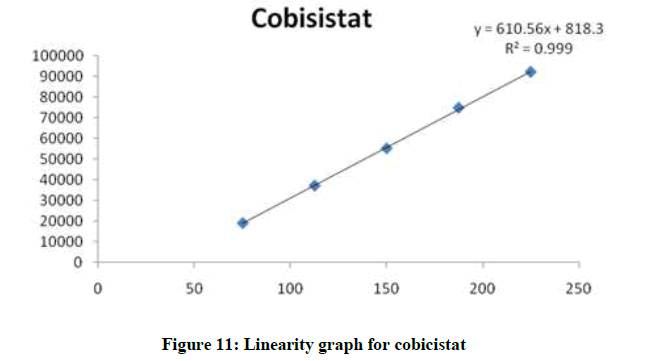Research Article - Der Pharma Chemica ( 2018) Volume 10, Issue 3
Determination of Simultaneous Estimation HPLC Method for Elvitegravir, Tenofovir Disoproxil Fumarate, Emtricitabine and Cobicistat it’s Pure And Tablet Form
Godasu SK* and Sreenivas SA
Mewar University, Chittorgarh, Rajasthan, India
Abstract
A new method was established for simultaneous estimation of elvitegravir, tenofovir, emtricitabine and cobicistat by using Reverse Phase-High Performance Liquid Chromatography (RP-HPLC) method. Chromatographic separations were carried using Inertsil ODS (4.6 × 250 mm, 5 μm) column with a mobile phase composition of 0.1% ortho phosphoric acid buffer and Acetonitrile (30:70) have been delivered at a flow rate of 1 ml/min and the detection was carried out using waters HPLC auto sampler, separation module 2695 with Photo Diode Array (PDA) detector 2996 at wavelength 252 nm. The retention time for elvitegravir, tenofovir, emtricitabine and cobicistat were 2.287, 2.957, 5.652 and 9.801 min respectively. The correlation coefficient values in linearity were found to be 0.999 and concentration range 75-225 μg/ml for elvitegravir, 150- 450 μg/ml for tenofovir, 100-300 μg/ml for emtricitabine and 75-225 μg/ml for cobicistat respectively. The accuracy recovery was found to be 100.11%, 100.26, 100.64 and 100.08% for elvitegravir, tenofovir, emtricitabine and cobicistat respectively. The Limit of Detection (LOD) and Limit of Quantification (LOQ) for Elvitegravir was found to be 2.98 and 9.98, LOD and LOQ for Tenofovir was found to be 3.02 and 10.02, LOD and LOQ for Emtricitabine was found to be 3.00 and 10.00 and LOD and LOQ for Cobicistat was found to be 3.00 and 10.02. The force degradation studies were performed for the dosage form and the results are within the limits. The results of study showed that the proposed RP-HPLC method is a simple, accurate, precise, rugged, robust, fast and reproducible, which may be useful for the routine estimation of elvitegravir, tenofovir, emtricitabine and cobicistat in pharmaceutical dosage form.
Keywords
Elvitegravir, Tenofovir, Emtricitabine, Cobicistat, RP-HPLC, Simultaneous estimation
Introduction
Emtricitabine is a nucleoside reverse transcriptase inhibitor for the treatment of human immunodeficiency virus IV infection in adults [1]. Emtricitabine is relating to cytidine. The drug shows action by inhibiting reverse transcriptase, the enzyme that copies Human Immuno Virus RNA into new viral DNA [2]. The IUPAC name of Emtricitabine is 4-amino-5-fluoro-1-[(2R,5S)-2-(hydroxymethyl)-1-3-oxothiolan-5- yl]pyrimidin-2-one (Figure 1).
Elvitegravir is a human immunodeficiency virus type 1 integrase strand transfer inhibitor used for the treatment of HIV-1 infection in antiretroviral treatment-experienced adults. Because integrase is essential for viral replication, inhibition prevents the integration of HIV-1 DNA into the host genome and thereby blocks the formation of the HIV-1 provirus and resulting propagation of the viral infection [3,4]. The IUPAC name of Elvitegravir is 6-(3-chloro-2-fluorobenzyl)-1-(1-hydroxy-3-methylbutan-2-yl)-7-methoxy-4-oxo-1,4-dihydroquinoline-3-carboxylic acid (Figure 2).
Cobicistat trade name Tybost, drug of choice for the treatment of infection with human immune deficiency virus. Although it does not have any anti-HIV activity, cobicistat acts as a pharmacokinetic enhancer by preventing action of cytochrome P450 3A isoforms (CYP3A) and therefore increases the systemic exposure of co administered agents that are metabolized by CYP3A enzymes [5]. Chemically known as Cobicistat (Figure 3) is 1,3-thiazol-5-ylmethyl N-[(2R,5R)-5-[[(2S)-2-[[methyl-[(2-propan-2-yl-1,3-thiazol-4-yl)methyl]carbamoyl]amino]-4-morpholin-4- ylbutanoyl]amino]-1,6-diphenylhexan-2-yl]carbamate.
Tenofovir disoproxil fumarate (TDF) is a forerunner (prodrug) of tenofovir, marketed by Gilead Sciences under the trade name Viread, belongs to a class of antiretroviral drugs [6]. The name of Tenofovir disoproxil fumarate (Figure 4) is ({[(2R)-1-(6-amino-9H-purin-9-yl) propan-2- yl]oxy}methyl)phosphonic acid.
From the Literature review there is a less methods are available for these combination so in order to get a new method for these combination and estimation by using Reverse Phase-High Performance Liquid Chromatography (RP-HPLC) [7-16]. The developed method was validated according to International Conference on Harmonization (ICH).
Materials and Methods
Chemicals and reagents: Elvitegravir, tenofovir, emtricitabine and cobicistat were supplied by Hetero Labs, Hyderabad. Dosage form was purchased by Local Pharmacy. Ortho phosphoric acid was analytical grade supplied by Finer chemical LTD, Mumbai, water and methanol for HPLC from fisher scientific.
Equipment and chromatographic conditions: The chromatography was performed on a Waters 2695 HPLC system, equipped with an auto sampler, PDA detector and Empower 2 software. Analysis was carried out at 252 nm with an Inertsil ODS (4.6 × 250 mm, 5 μm) dimensions at ambient temperature. The optimized mobile phase consists of 0.1% OPA and acetonitrile in the ratio of 30:70 v/v. Flow rate was maintained at 1 ml/min and run time for 15 min.
Preparation of solutions
Preparation of buffer
The buffer was prepared by taking 1 ml of into a 1000 ml of V.F. and the volume was make up to the mark with HPLC water then the solution was filter through 0.45 μ filter and sonicate it for 15 min.
Preparation of mobile phase
Mobile phase was prepared by adding 300 ml of acetonitrile buffer 700 ml of acetonitrile into 1000 ml V.F.
Preparation of EVT, TNF, ETC, CBS standard stock solution: The standard solution was prepared by adding 75 mg of elvitegravir pure drug, 150 mg of Tenofovir TDF, 100 mg of Emtricitabine and 75 mg of cobicistat pure drug into a 100 ml of V.F. to this add about 70 ml of mobile phase sonicate it for 5 min (stock). From above stock take 2 ml make up to 100 ml with mobile phase (Figure 5).
Preparation of sample stock solution: The Sample stock solution was prepared by taking an equivalent weight of 10 tablet powder of ETEC into a 100 ml of V.F. and add about 70 ml of Mobile phase sonicate it for 5 min (stock). From above stock take 2 ml make up to 100 ml with mobile phase (Figures 6 and 7).
Procedure: Inject 20 μl of the standard stock sample stock into the HPLC system.
Method: The optimized chromatographic conditions are: Column: Inertsil ODS (4.6 × 250 mm, 5 μm), flow rate: 1 ml/min, injecting a volume: 20 μl, run time: 15 min, Λmax: 265 nm, mobile phase: 0.1% OPA buffer and acetonitrile (30:70). Retention time, tailing factor and USP theoretical plate count of the developed method are shown in Table 1.
| Parameters | Elvitegravir | Tenofovir | Emtricitabine | Cobicistat |
|---|---|---|---|---|
| Retention time | 2.287 | 2.957 | 5.652 | 9.801 |
| USP Plate count | 3944 | 2963 | 5926 | 4461 |
| USP Tailing | 1.34 | 1.29 | 1.37 | 1.13 |
| USP Resolution | -- | 3.19 | 10.49 | 12.25 |
Table 1: System suitability parameters
Assay of pharmaceutical formulation: The proposed validated method was successfully applied to determine elvitegravir, tenofovir, emtricitabine and cobicistat in their tablet dosage form. The result obtained for elvitegravir, tenofovir, emtricitabine and cobicistat was comparable with the corresponding labeled amounts and they were shown in Table 2.
| Label claim (mg) | % Assay | |||
|---|---|---|---|---|
| Elitragravir | 150 | 99.21 | ||
| Tenofovir DF | 300 | 99.80 | ||
| Emtricitabine | 200 | 99.80 | ||
| Cobicistat | 150 | 99.84 | ||
Table 2: Assay results for elvitegravir, tenofovir, emtricitabine and cobicistat
Validation of analytical method
Linearity and range
Linearity solution was prepared by dissolving Elvitegravir, Tenofovir, Emtricitabine and cobicistat in 100 ml of diluent and further diluted to the required concentrations with diluent. The solution was prepared at five concentration levels ranging from 75 μg/ml to 225 μg/ml of elvitegravir, 150 μg/ml to 450 μg/ml of tenofovir, 100 μg/ml to 300 μg/ml of emtricitabine and 75 μg/ml to 225 μg/ml of cobicistat. Inject each level into the chromatographic system and measure the peak response. Plot a graph of peak area versus concentration (on X-axis concentration and on Y-axis Peak area) and calculate the correlation coefficient (Figures 8-11). The results are shown in Tables 3 and 4.
| Elvitegravir | Tenofovir | ||
|---|---|---|---|
| Concentration (µg/ml) | Area | Concentration (µg/ml) | Area |
| 75 | 31158 | 150 | 174283 |
| 112.5 | 62501 | 225 | 346309 |
| 150 | 98431 | 300 | 534616 |
| 187.5 | 126883 | 375 | 738393 |
| 225 | 159437 | 450 | 910971 |
| Correlation coefficient | 0.999 | Correlation coefficient | 0.999 |
Table 3: Linearity results for elvitegravir and tenofovir
| Emtricitabine | Cobicistat | ||
|---|---|---|---|
| Concentration (µg/ml) | Area | Concentration (µg/ml) | Area |
| 100 | 200028 | 75 | 19268 |
| 150 | 412844 | 112.5 | 37340 |
| 200 | 616857 | 150 | 55298 |
| 250 | 842986 | 187.5 | 74833 |
| 300 | 1052774 | 225 | 92106 |
| Correlation coefficient | 0.999 | Correlation coefficient | 0.999 |
Table 4: Linearity results for emtricitabine and cobicistat
Accuracy
The accuracy was determined by help of recovery study. The recovery method carried out at three level 50%, 100% and 150%. Inject three levels of accuracy samples into chromatographic system. Calculate the amount found and amount added for elvitegravir, tenofovir, emtricitabine and cobicistat and calculate the individual recovery and mean recovery values. The % recovery was found to be within the limits. The results are shown in Tables 5-8.
| %Concentration (at specification level) | Area | Amount Added (mg) | Amount found (mg) | % Recovery | Mean recovery |
|---|---|---|---|---|---|
| 50% | 31749 | 37.5 | 37.98 | 101.28 | 100.11 |
| 100% | 62401 | 75 | 74.65 | 99.53 | |
| 150% | 93601 | 112.5 | 111.97 | 99.53 |
Table 5: accuracy results for elitragravir
| %Concentration (at specification level) | Area | Amount Added (mg) | Amount Found (mg) | % Recovery | Mean Recovery |
|---|---|---|---|---|---|
| 50% | 172009.3 | 50 | 75.15 | 100.20 | 100.26 |
| 100% | 346657 | 100 | 151.45 | 100.97 | |
| 150% | 512951.7 | 150 | 224.11 | 99.60 |
Table 6: Accuracy results for tenofovir
| %Concentration (at specification level) | Area | Amount Added (mg) | Amount Found (mg) | % Recovery | Mean Recovery |
|---|---|---|---|---|---|
| 50% | 207597 | 50 | 50.24 | 100.49 | 100.64 |
| 100% | 415239 | 100 | 100.50 | 100.50 | |
| 150% | 625553 | 150 | 151.40 | 100.93 |
Table 7: Accuracy results for emtricitabine
| %Concentration (at specification level) | Area | Amount Added (mg) | Amount Found (mg) | % Recovery | Mean Recovery |
|---|---|---|---|---|---|
| 50% | 18910 | 37.5 | 37.69 | 100.52 | 100.08 |
| 100% | 37496 | 75 | 74.74 | 99.65 | |
| 150% | 56478 | 112.5 | 112.58 | 100.07 |
Table 8: Accuracy results for cobicistat
Precision
The precision was calculated from coefficient of variance for six replicate injections of the standard. The 100% standard solution was injected for six times and measured the area for all six injections in HPLC. The %RSD for the area of six replicate injections was found. The results are shown in Table 9.
| Injection | Elvitegravir | Tenofovir | Emtricitabine | Cobicistat |
|---|---|---|---|---|
| Injection-1 | 62521 | 340835 | 412366 | 37719 |
| Injection-2 | 63501 | 345902 | 417933 | 37131 |
| Injection-3 | 63131 | 340203 | 418246 | 37145 |
| Injection-4 | 62349 | 343151 | 410461 | 37488 |
| Injection-5 | 64024 | 341901 | 413907 | 37380 |
| Injection-6 | 63398 | 341902 | 416726 | 37139 |
| Average | 63154 | 342315.7 | 414939.8 | 37333.67 |
| Standard Deviation | 630.252 | 2027.726 | 3188.463 | 240.421 |
| %RSD | 1 | 0.6 | 0.8 | 0.6 |
Table 9: Precision results for elvitegravir, tenofovir, emtricitabine and cobicistat
Ruggedness
To evaluate the intermediate precision (Also known as intermediate precision) of the method, precision was performed on different day. The standard solution of target concentration was injected for six times and measured the area for all six injections in HPLC. The %RSD for the area of six replicate injections was found. The result is shown in Table 10.
| Injection | Elvitegravir | Paritaprevir | Emtricitabine | Cobicistat |
|---|---|---|---|---|
| Injection-1 | 62421 | 350835 | 418366 | 38019 |
| Injection-2 | 62501 | 345902 | 417933 | 37131 |
| Injection-3 | 62131 | 349203 | 418246 | 37145 |
| Injection-4 | 62349 | 343151 | 419461 | 37488 |
| Injection-5 | 62024 | 349901 | 419907 | 37380 |
| Injection-6 | 62398 | 346902 | 419726 | 37239 |
| Average | 62304 | 347649 | 418939.8 | 37400.33 |
| Standard deviation | 185.3041 | 2880.244 | 854.3403 | 333.0499 |
| %RSD | 0.2 | 0.8 | 0.2 | 0.9 |
Table 10: Ruggedness results for elvitegravir, tenofovir, emtricitabine and cobicistat
Robustness
As part of the Robustness, deliberate change in the flow rate, mobile Phase composition, Temperature Variation was made to evaluate the impact on the method. The flow rate was varied at 0.8 ml/min to 1.2 ml/min. The organic composition in the mobile phase was varied from 63% to 77%.
The Limit of Detection (LOD) and Limit of Quantification (LOQ)
The sensitivity of RP-HPLC was determined from LOD and LOQ. Which were calculated from the calibration curve using the following equations as per ICH Q2 R1 guide lines.
Force degradation studies
The ICH guideline entitled stability testing of new drug substances and products requires that stress testing be carried out to elucidate the inherent stability characteristics of the active substance. The aim of this work was to perform the stress degradation studies on the Elvitegravir, Tenofovir, Emtricitabine and Cobicistat using the proposed method. The results are shown in Table 11.
| Parameters | Elvitegravir | Tenofovir | Emtricitabine | Cobicistat | ||||
|---|---|---|---|---|---|---|---|---|
| Area | % Degraded | Area | % Degraded | Area | % Degraded | Area | % Degraded | |
| Standard | 62572 | 342646 | 412362.7 | 37550.7 | ||||
| Acid | 60297 | 3.64 | 331313 | 3.31 | 393095 | 4.67 | 35645 | 5.08 |
| Base | 60635 | 3.10 | 329952 | 3.70 | 399441 | 3.13 | 35835 | 4.57 |
| Peroxide | 60293 | 3.64 | 316915 | 7.51 | 396871 | 3.76 | 35209 | 6.24 |
| Photo | 601121 | 3.92 | 325902 | 4.89 | 380461 | 7.74 | 35488 | 5.49 |
| Thermal | 60121 | 3.76 | 325462 | 5.02 | 393431 | 4.59 | 35432 | 5.64 |
Table 11: Degradation results for elvitegravir, tenofovir, emtricitabine and cobicistat
Acid hydrolysis
Pipette 2.0 ml of above solution into a 10 ml volumetric flask and 3 ml of 0.1 N HCl was added. Then, the volumetric flask was kept at 60°C for 6 h and then neutralized with 0.1 N NaOH and make up to 10 ml with diluent. Filter the solution with 0.22 microns syringe filters and place in vials.
Alkaline hydrolysis
Pipette 2.0 ml of above solution into a 10 ml volumetric flask into and add 3 ml of 0.1 N NaOH was added in 10 ml of volumetric flask. Then, the volumetric flask was kept at 60°C for 6 h and then neutralized with 0.1 N HCl and make up to 10 ml with diluent. Filter the solution with 0.22 microns syringe filters and place in vials.
Oxidative degradation
Pipette 2.0 ml above stock solution 2 into a 10 ml volumetric flask, 1 ml of 3% w/v of hydrogen peroxide added and the volume was made up to the mark with diluent. The volumetric flask was then kept at room temperature for 15 min. Filter the solution with 0.45 microns syringe filters and place in vials.
Results and Discussion
Thermal induced degradation
Elvitegravir, tenofovir, emtricitabine and cobicistat sample was taken in petridish and kept in Hot air oven at 110°C for 24 h. Then the sample was taken and diluted with diluents and injected into HPLC and analysed.
Photo degradation: Pipette 2.0 ml above stock solution into a 10 ml volumetric flask and expose to sunlight for 24 h and the volume was made up to the mark with diluent. Filter the solution with 0.45 microns syringe filters and place in vials.
Assay calculation for elvitegravir

Assay calculation for tenofovir

Assay Calculation for emtricitabine

Assay calculation for cobicistat

Conclusion
The developed HPLC method was validated and it was found to be simple, precise, accurate and sensitive for the simultaneous estimation of elvitegravir, tenofovir, emtricitabine and cobicistat in its pure form and in its pharmaceutical dosage forms. Hence, this method can easily and conveniently adopt for routine quality control analysis of elvitegravir, tenofovir, emtricitabine and cobicistat in pure and its pharmaceutical dosage forms.
References
- L.M. Bang, L.J. Scott, Drugs., 2003, 63, 2413-2424.
- M.S. Saag, Reviews of Anti-infective Agents., 2006, 42, 126-131.
- A.R. Zolopa, D.S. Berger, H. Lampiris, L. Zhong, S.L. Chuck, J.V. Enejosa, J. Infect. Dis., 2010, 201, 814-822.
- J.S. Janson, E.S. Kathleen, Ann. Pharmacother., 2010, 44, 145-156.
- E.D. Deeks, Drugs., 2014, 74, 195-206.
- H.B. Fung, E.A. Stone, F.J. Piacenti, Clin. Ther., 2002, 24, 1515-1548.
- B. Lavanya, P. Hariprasad, A. Venkatapraveen, D. Prasannalakshmi, Int. Res. J. Pharm., 2012, 3, 104-108.
- B. Lavanya, P. Hariprasad, A. Venkatapraveen, D. Prasanna lakshmi, M. Ramireddy, Der Pharmacia Lett., 2012, 4, 99-105.
- U. Fatima, T. Mamatha, G. Rajesh, Der Pharmacia Sinica., 2014, 5, 99-105.
- J. Raghu Ram, V. Kiran Kumar, N. Appala Raju, Pharm Methods., 2014, 5, 7-13.
- V.V. Babu, Raveendra, Sharma, K. Pankaj, I. Singhvi, Asian J. Chem., 2014, 26, 6233-6237.
- S. Ashwini, P.A. Slunke, S.D. Barhate, M.M. Bari, World J. Pharm. Res., 2015, 4, 995-1006.
- V. Viswanath, P. Shanmugasundaram, V. Ravichandiran, Int. J. Pharm. Tech. Res., 2013, 5, 1186-1195.
- K. Deepthi, G. Nagarjun, K. Dhanalakshmi, Int. J. Pharm. Res. Rev., 2013, 2, 1-11.
- D. Ashenfi, M. Ungerbock, J. Hoogmartens, E. Adams, Chromatographia., 2013, 76, 1495-1503.
- M. Balaji, I. Srikanth, S. Reddy, G. Krishna, S. Ramu, V. Kumar, J. Pharm. Res., 2012, 5, 4692-4694.

